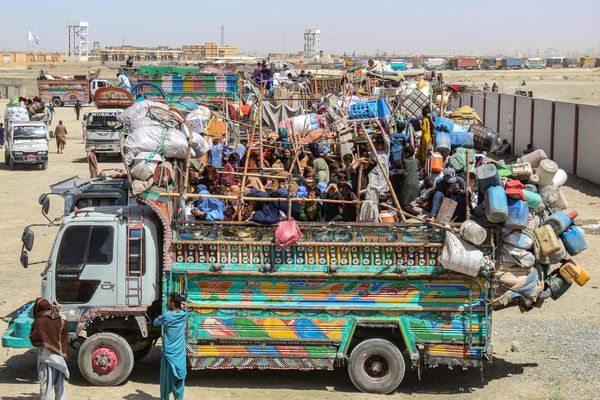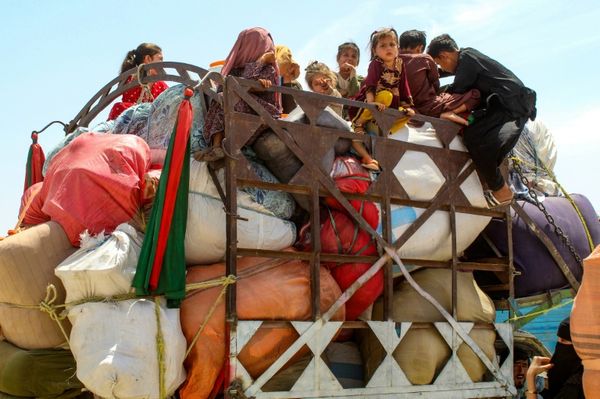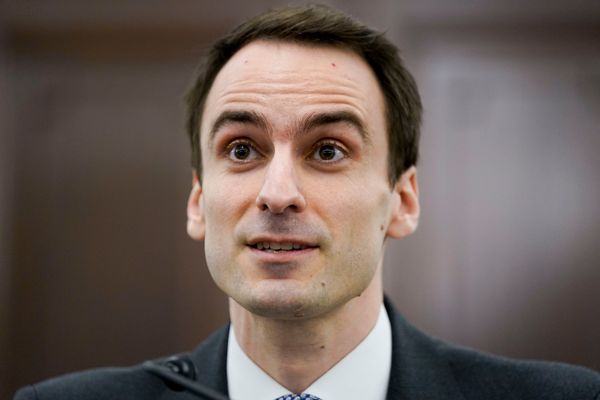
Tinsel glistens through the window of the darkened classroom. But the decorations are not from this Christmas, or last. A whiteboard marks the date when pupils and staff were evacuated in a hurry from Sacred Heart Catholic primary school nearly two years ago.
It was 16 January 2023 when a routine inspection found that the floor of the 95-year-old school building was rotten and could collapse any moment. Children would have plunged into the rat-infested cellar below.
“He said: ‘Get out now. There’s a danger to life,’” recalls Simone Beach, the headteacher of the school in Barrow-in-Furness, Cumbria, which serves some of the most deprived pupils in the UK, in sight of the high-security BAE Systems docks where multibillion-pound nuclear submarines are made.
The evacuation was supposed to be only short-term, but two years later the children have not returned. They may not be back in class until 2029, seven years after they were forced to leave, because the rotting building has now been condemned as unsafe.
Each weekday morning at 8am, about 200 young children meet outside their old school, braving Cumbria’s freezing winters and regular rain as they pile on to three coaches for the two-mile journey to St Bernard’s Catholic high school, where they are temporarily housed.
A journey that should take no longer than 15 minutes takes much longer as staff corral and cajole dozens of little bodies on and off vehicles, up a steep driveway and into school. It is 9.30am by the time they sit down in class. The children, says Beach, are wired, tired and “often not ready to learn”.
Each pupil is losing about 10 hours of teaching time a week, according to the headteacher – 130 hours in a typical primary school term. And it is showing in their results.
Last summer, fewer than half of pupils (46%) met the expected standard for reading, writing and maths at the end of key stage 2. That compares with about 60% in the local authority and in England overall. This summer, that had plummeted to 18%.
Teachers say this year’s results were affected by having a higher number of children with special educational needs. But it is also, they say, an undeniable consequence of the upheaval.
When the Guardian visited in mid-December, on a day when temperatures hovered above freezing, groups of five- and six-year-olds huddled against the cold in a queue for the temporary outdoor toilets they use instead of the main facilities.
If one child in a group needs the toilet mid-lesson, the whole group has to stand outside the Portakabin and wait for them, so pupils are not left unattended inside. When there is only one staff member in a class, all the pupils have to stand outside to wait for one child to use the toilet.
Inside, children have to do one-to-one work on the floor in corridors. This includes the 60 pupils identified as having additional needs (which, at 28% of the school roll, is far higher than the national average).
Temporary classrooms have been set up in a finance office, an HR room and a storage facility with tattered carpets and blown windows. None of the rooms have sinks, so there is no painting or messy artwork, which Ofsted says should “command an important place in every school”.
Nor can they do the minimum two hours of PE a week, due to the lack of space. “This is an area where things like obesity, tooth decay, constipation are all really, really high,” said Beach.
“Many of our children don’t access community sport. The majority aren’t going to private horse riding lessons, so the sport they get is the sport we give.”
The densely packed terraced streets surrounding Sacred Heart are some of the poorest in England. One in five people left school with no qualifications and at least 33% are out of work, compared with 22% across the UK. Smart two-bedroom homes sell for only £35,000, similar to the average deposit for a house in the rest of north-west England.
“These children are some of the most disadvantaged children in the town and this situation is just compounding that,” Beach said. “We’ve been collectively failed.”
When they were evacuated from the old Sacred Heart school building, based in a church built in 1909, staff found equipment covered in rodent droppings and children’s books infested with damp spores. Books that were destined for landfill have since been donated to the school by a local library.
In the St Bernard’s playground, the primary school pupils are sequestered away from the older children in a tennis court, nicknamed “the cage”. The outdoor space for the reception class – those aged four and five – is a muddy patch of grass with two tyres next to the car park, which has been out of bounds for weeks because the temporary metal fencing keeps blowing over.
Beach has pleaded with the Department for Education (DfE) and other agencies for money and expertise but is disappointed with the response of senior leaders.
No DfE official visited the school until October 2023, 10 months after the evacuation, and the local authority did not visit until December – almost a year after it was forced to close.
The DfE has agreed to reimburse some of Sacred Heart’s extra staffing costs but refused to pay for the coaches, which cost £4,865 a week. The department initially declined to reimburse the cost of the school’s temporary outdoor toilets but reversed the decision this month after being made aware of this story.
Beach said the upheaval would leave her school hundreds of thousands of pounds in deficit: “That money is for the children, isn’t it? It’s just come from our normal school budget that other schools use for catch-up reading programmes, or trips to National Trust parks, or violin lessons. But our money is being spent on toilets.”
After initially being refused emergency funding in September 2023, the school was later accepted on to the schools rebuilding programme, announced by the previous government after the scandal over crumbling concrete.
It is not unusual for ministerial motorcades to whizz past Sacred Heart’s rotting building and into BAE Systems, across the road, where tens of billions of pounds are being spent on Britain’s nuclear submarines.
The awkward juxtaposition is not lost on Beach: “If I live in a town where I can see them building submarines that cost billions of pounds from my school window, how is it that no one can help me when our school’s broke?”
“All that money and all that expertise on the nuclear submarines and yet our school has been homeless for two years. That just seems bonkers to me. I feel like it’s because of where we are and the community we serve. I just don’t think this would happen to a school in a posh, leafy suburb.”
The Conservative party has been contacted for comment. A DfE spokesperson said it had “inherited a school estate in dire need of repair” and it was “committed to turning it around for staff and pupils, turning the page on drift and neglect”.
The DfE said Sacred Heart was on its school rebuilding programme and it was working with the school’s academy trust, which took control of it just over two years before the inspection, by “supporting the temporary provision so every child has a suitable education”.







